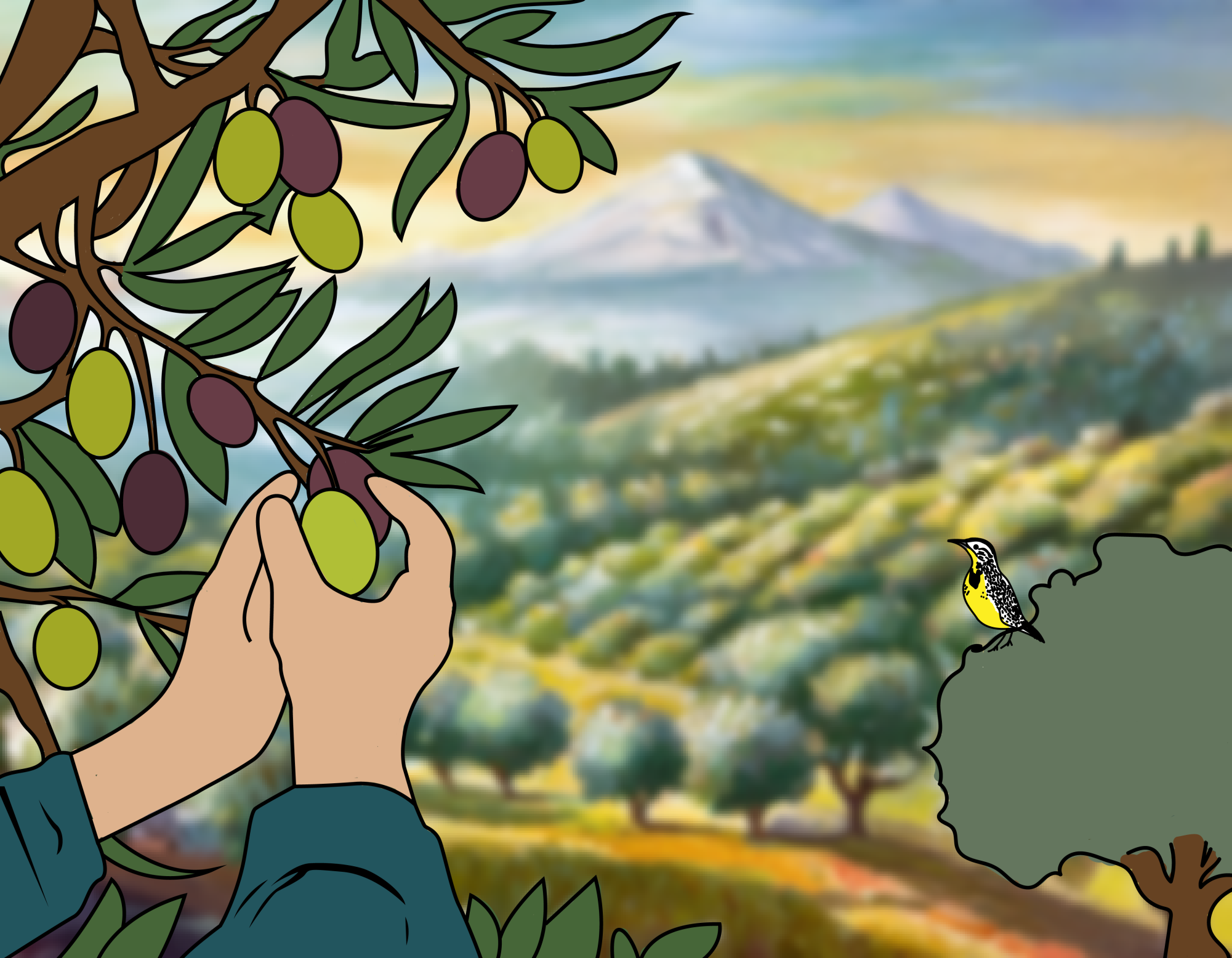When you picture an olive farm, you may imagine a warm, sunny Mediterranean country like Spain or Greece.
While Oregon, with its rainy, cold winters may not jump to mind, Oregon State University’s Olea Project is working closely with farmers to make Oregon a more viable olive producer.
In 2017, after Oregon olive farmers reached out to researchers at OSU, the Olea Project was founded with, according to the project’s website, “goals of making olive production economically feasible and reducing climatic limitations for olive growers during establishment in Oregon’s unique growing conditions.”
Though the project consists only of a team of three – retired Community Horticulturist Neil Bell, Community Horticulturist and Small Farms Extension Agent for Yamhill County Heather Stoven, and Agricultural Outreach Coordinator Hayley White – the project has been very active in the past six years in developing olives into a more viable crop for Oregon farmers.
“(The Olea Project) received a couple grants to help out with olive growers and then it’s just kind of gone from there,” Stoven said. “There’s been a lot of interest (in the program). And so we’ve done our best to keep this project going as well as we can with our capacities.”
The unique qualifications of the team members help to offset some of the issues that having such a small research team may otherwise experience.
“For many years, Heather Stoven and I have researched woody landscape plants for un-irrigated landscapes in the Willamette Valley, collecting data on cold hardiness, growth, flowering and pest and disease issues,’ Bell said. “Although olive is a tree fruit crop, the basic idea and methodology is similar to the work we had already been doing.”
Bell went on to say that a big factor in his initial involvement in the project was the opportunity to learn about olives and to provide better cultivars to the olive growers in the Willamette Valley.
As it turns out, though olives originally come from the hotter, drier Mediterranean region, with a little help, they grow quite well in Oregon.
“Olives grow well in Oregon and produce fruit which bear a very good quality oil,” Bell said. “The origin of the species, Olea europaea, is the Mediterranean basin, where much of the world’s production occurs. It has been cultivated there for thousands of years and hundreds of cultivars exist, most of which are not available in North America.”
Bell said that other regions of the world that share a Mediterranean climate include parts of Australia, South Africa and California, which all produce olives and olive oil.
“Western Oregon could be described as a ‘temperate’ Mediterranean climate, with the characteristic cool, wet winters and warm, dry summers,” Bell said.
According to Stoven and Bell, Oregon’s rainfall isn’t as much of a problem as one would assume for olives. The real threat to Oregon olives, they claim, comes in the winter months.
“It is a cooler summer climate than the Mediterranean or other production regions,” Bell said. “And as we have just seen, we are prone to periodic mid-winter freeze events, which are damaging to all above-ground tissues of the trees.”
Stoven said that the January cold snap was very concerning to the project.
“Olives can be damaged if the temperature is below 25 to 20 degrees Fahrenheit,” Stoven said. “Below that will cause damage to the trees. So if you’re at 25 degrees, you don’t see a lot of damage, but once you get down below 15 degrees, then you can start to see major damage and even tree death. So that is the major concern and it’ll be interesting to see what happens after.”
Bell said that one of the main purposes of the Olea Project is to find which cultivars grow best here in Oregon. He suggests that the cultivars that will grow best are those that show increased cold hardiness as well as having precocious flowering and fruiting and yield a quality olive and oil.
“We have an acre plot at the North Willamette Research and Extension Center, which is in Aurora,” Stoven said. “And within that plot we have 118 different cultivars. And they’re replicated four times. We are looking at comparing those different cultivars.”
According to Stoven, the cultivars were planted in July 2021, and it may take some time before the needed data is gathered.
“It’s only been a couple of winters, but this is the harshest winter we’ve had so far,” Stoven said. “So when the trees undergo a cold spell like this, it really takes until the spring to be able to determine what the effects of the cold are.”
Stoven went on to say that, since this latest cold snap brought the temperature at the plot to five degrees lower than it has before, the project should be able to get some interesting information from the trial.
Another concern that the Olea Project is researching is the susceptibility of olive cultivars to the emerald ash borer.
According to Bell, the emerald ash borer is an invasive insect native to Asia that is known to affect olive and ash trees and is very destructive.
It has also been found in eastern North America, and has been found in the Pacific Northwest, being discovered in Forest Grove, Oregon as early as June of 2022.
Stoven points out that this is the first time that the emerald ash borer has been in the same place as olives.
“Some research in Ohio found that emerald ash borers will attack olives,” Stoven said. “And so we’re not really sure how much of a problem this new pest will be for the crop. However, it has a real potential to cause a lot of damage.”
Stoven went on to say that that is something she is bringing up to farmers who are looking to get into the olive industry and who want to establish an orchard.
Despite the danger of our cold winters and the looming threat of an invasive species, Stoven points out that there are a lot of benefits to growing olives.
“So it’s pretty easy to plant (olive trees,)” Stoven said. “They do take a while to get mature and to get established, but beyond that they don’t require a lot of maintenance. There’s some pruning of course and fertilizing but compared to some other crops like I said they don’t need summer irrigation or they don’t need irrigation once they’re established, they are pretty pest free.”
Stoven also said that, since olives come from the Mediterranean region which has nutrient-poor soil, olive trees’ nutrient requirements are relatively low.
However, Stoven added that Oregon farmers may also have to lower the acid level of their soils before planting olive cultivars.
“The soils that we have here tend to be more acidic,” Stoven said. “And olives tend to come from regions that have soils that are more neutral to basic. So adding lime to soils before you plant is pretty common here.”
Stoven also said that, to offset the Oregon rain, farmers commonly plant on a berm or a slope to help with water drainage and so the crops won’t sit in cold air.
According to Stoven, while Oregon does not look to surpass California as the top olive grower in the country, Oregon growers do produce high-quality products that have even won some prestigious awards.
“It’s really definitely a value-added niche kind of crop for growers who will sell their olive oil to wineries where they’ll be used in tasting rooms, or they will also have a winery themselves,” said Stoven.












































































































